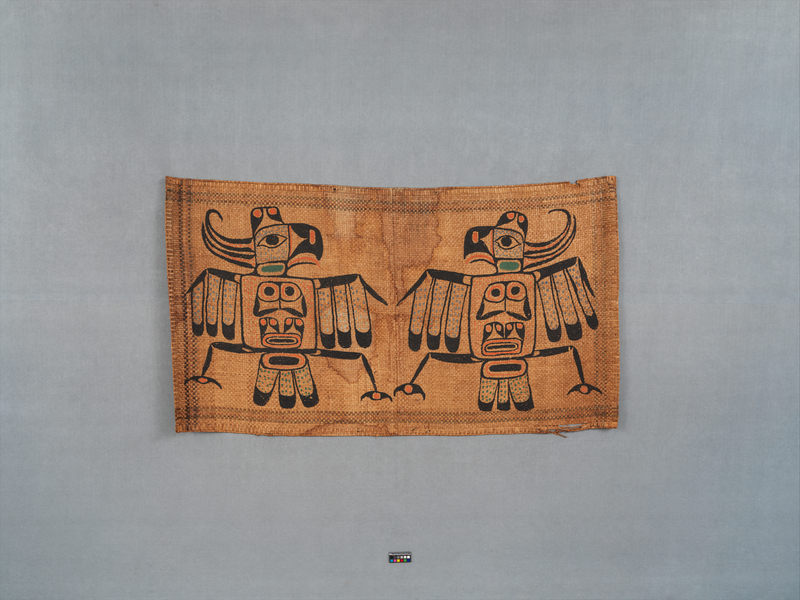Dance Screen Item Number: 3474/1 from the MOA: University of British Columbia

Description
Woven cedar bark screen with painted design in a horizontal orientation. Image is of two identical thunderbirds, bodies facing front and heads facing each other. Thunderbirds are outlined in black with formline designs throughout interior. Designs done in black with green and red-orange highlights. Each thunderbird has a curved horn on the back of their head and semi-circular shaped protrusion on top of their head. Thunderbirds have downward pointing wings and legs widely spread outward. Wings and tails have three feathers each and they are filled with dots. Wings have blue-grey dots, tail feathers have green. Main bodies are filled with red-orange dots, surrounding central designs, and head filled with blue-grey dots. Borders around all edges of screen are made of dyed(?) dark green-black strips of bark. The screen is edged with wide strips of bark.
History Of Use
Haa’yuups (Ron Hamilton) commented: “Over the years, I have seen a couple of other painted mats of this size possibly painted by the same individual. There is a tradition on our coast of Tlaaxsaata, Hakoma and Hikiitsim all, at times and for certain families, being danced with the dancer not coming onto the floor at all but rather staying behind a small thliitsapilthim during the entire dance. This painted mat may have functioned once in this capacity."
Narrative
The donor inherited the screen from her father, Robert S. Alexander (1916-1974), a BC artist.
Item History
- Made in Vancouver Island, British Columbia, Canada during 1940
- Owned by Renee Alexander before January 27, 2021
- Received from Renee Alexander (Donor) on January 27, 2021
What
- Name
- Dance Screen
- Identification Number
- 3474/1
- Type of Item
- screen
- Material
- dye, cedar bark and paint
- Overall
- height 92.9 cm, width 165.7 cm
Who
- Culture
- Nuu-chah-nulth
- Previous Owner
- Renee Alexander
- Received from
- Renee Alexander (Donor)
Where
- Holding Institution
- MOA: University of British Columbia
- Made in
- Vancouver Island, British Columbia, Canada
When
- Creation Date
- during 1940
- Ownership Date
- before January 27, 2021
- Acquisition Date
- on January 27, 2021
Other
- Item Classes
- basketry
- Condition
- good
- Accession Number
- 3474/0001